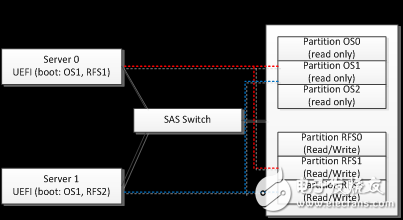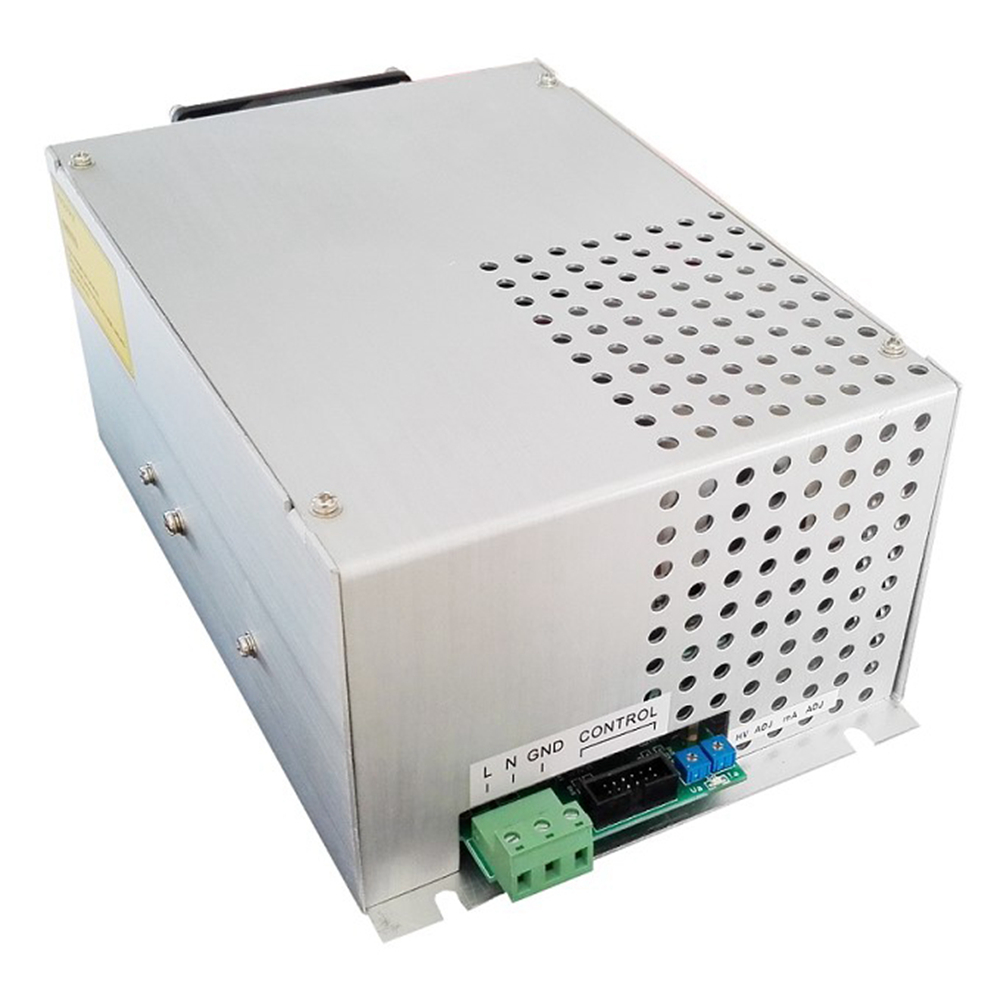Optimizing storage and boot services on a SAS Switch-based architecture offers significant advantages, especially in large-scale data centers. One key service is the management of shared boot disks. Each server in a cluster typically requires a volume with an operating system, along with a root file system and swap space. While the OS image is usually read-only and may be shared across multiple machines, the root file system is often unique to each server and needs to be writable. Managing these volumes for hundreds of servers can be costly and operationally complex. By implementing a shared boot disk solution, we can reduce hardware costs, simplify maintenance, and improve efficiency.
Using a SAS Switch, we can create multiple partitions on a single high-performance disk (such as a SAS SSD) or a pair of disks for redundancy. These partitions serve two main purposes: one for shared operating system images that can be used across multiple servers, and another for individual root file systems specific to each machine. The SAS Switch allows these partitions to be accessed by any server in the cluster, enabling centralized boot management. On the server side, a UEFI BIOS application is used to configure the boot process, selecting the appropriate OS partition and root file system from the shared disk.

In an example setup, two servers (server 0 and server 1) share a boot disk through the SAS Switch. Server 0 uses OS partition 1 and has its own root file system on RFS1, while server 1 uses the same OS partition but has its root file system on RFS2. This ensures that both servers operate independently without interfering with each other. However, relying on a single shared disk can introduce reliability risks. To mitigate this, multiple shared boot disks can be deployed across different fault domains—such as separate JBODs or racks—so that a single failure does not bring down the entire cluster.
Beyond cost savings, shared boot disks also streamline operations. For instance, updating the OS or applications becomes much easier since changes only need to be made on the shared disk rather than individually on each server. In the event of hardware failure, a server can be replaced without needing to reinstall the OS or software, significantly reducing downtime and operational overhead in large-scale environments.
**Flexible Migration and Protection of Dynamic Services**A SAS Switch enables flexible migration and protection of dynamic services by allowing all nodes in a domain to access shared storage resources. This is particularly useful in scenarios like Hadoop clusters, where resource allocation can change dynamically based on workload.
For example, consider a Hadoop cluster initially configured with 10 servers and 20 data disks. After performance monitoring reveals low CPU utilization, the system can be reconfigured to reduce the number of compute nodes. The SAS Switch allows this reconfiguration to happen online, redistributing data disks to fewer servers and freeing up idle resources for other tasks. This flexibility helps maximize hardware utilization and improves overall efficiency.
In high-reliability environments, the SAS Switch can also support failover mechanisms. If a server fails, the service it was running can be automatically transferred to an idle node, ensuring continuous operation. Storage resources are reassigned accordingly, and the entire process can occur without interrupting the service, making the system more resilient and adaptable.
**Hyper-Converged Storage**Hyper-converged storage solutions, such as Nutanix and VMware vSAN, are gaining traction due to their ability to combine compute and storage resources into a single platform. This approach eliminates the need for dedicated storage hardware and simplifies infrastructure management.
Despite this trend, many hyper-converged implementations still rely on technologies like SAS Switches. By using high-density servers paired with SAS Switches and JBODs, organizations can achieve a balance between cost, scalability, and performance. This architecture allows for better resource utilization, decoupling storage from compute, and supporting multi-tenant environments securely.
There are several reasons why this approach is effective. First, moving disks to JBODs reduces the cost per server. Second, separating storage and compute resources allows for more efficient hardware utilization based on application needs. Third, physical isolation of data is easier to implement with SAS Switches, which is essential for multi-tenant environments where data security is a priority.
As seen in China’s data centers, SAS Switch technology has matured and is being widely adopted. This shift has enabled more advanced, flexible, and cost-effective cloud infrastructures. Internationally, major server vendors and data centers are also embracing this model, proving that the future of storage lies in pooling and decoupling resources for greater efficiency and scalability.
The CCP1000 series high-voltage power supply module is a single-phase 220Vac input modular high-voltage power supply. The whole series adopts unified small and compact aluminum chassis with the designed output power at 1KW, and the output voltage levels at 5KV / 10KV / 20KV / 30KV / 40KV / 50KV for selection.

The HV power module is also equipped with a DB9 interface to facilitate the bus control of embedded installation equipment. Customers can apply 0-10V signals and dry contact signals to the interface according to our interface definition to achieve comprehensive control and monitoring functions on the power supply, like high voltage start / stop, output setting and reading.
The CCP1000 high voltage power modules are equipped with complete protection functions, which can deal with sparking, short-circuit, and overload conditions. With the discharge protection circuit recommended by iDealTek-Electronics, the high-voltage module can also cope with conventional capacitor charging and discharging conditions.
At present, the high voltage power modules are mainly used in air or oil fume purification, capacitor charging and other application fields that require a high-voltage power module that can be embedded installation.
High Voltage Module,High Voltage Power Module,High Voltage Booster Module,High Voltage Power Supply Module
Yangzhou IdealTek Electronics Co., Ltd. , https://www.idealtekpower.com